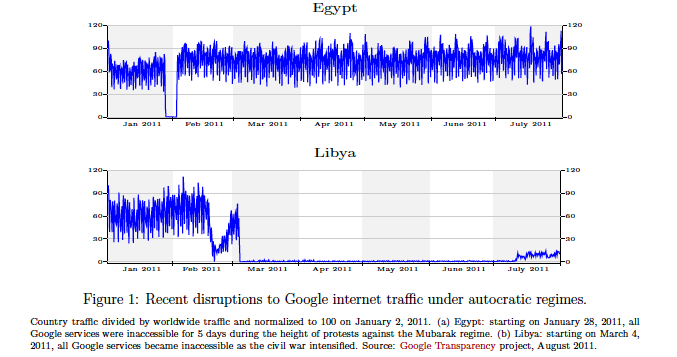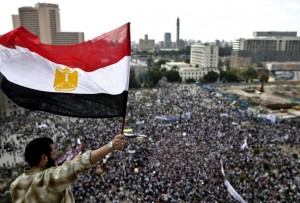The Revolution Will Not Be Televised. But It Will Be Tweeted
A new paper from Chris Edmond at the University of Melbourne examines how the quantity and quality of information impacts regime change. This is particularly timely in light of the Arab Spring taking place across the Middle East, and the current goose chase for Muammar Gaddafi. As demonstrated by the disruption of Google during the uprisings in Egypt and Libya (shown below), a regime will go to great lengths to shut down the proliferation of non state-controlled media.


An Egyptian protester waves his national flag as tens of thousands gather for a demonstration at Cairo's Tahrir Square on April 8, 2011, two months after president Hosni Mubarak was ousted, to demand that former regime officials including the veteran strongman be purged and tried. AFP PHOTO/MISAM SALEH (Photo credit should read MISAM SALEH/AFP/Getty Images)
Edmond constructs a simple model to study how a regime’s chances of survival are affected by changes in information technology. He finds that information alone does not destabilize an oppressive regime. In fact, more information (and the control of that information) is a major source of political strength for any ruling party. The state controlled media of North Korea is a current example of the power of propaganda, much as it was in the Soviet Union and Nazi Germany, where the state heavily subsidized the diffusion of radios during the 1930s to help spread Nazi propaganda.
Also, changes in technology do not by themselves weaken the state. While Twitter played a role in the Iranian protests in 2009, the medium was used effectively by the Iranian regime to spread rumors and disinformation. But, if information becomes not just more widespread but more reliable, the regime’s chances of survival are significantly diminished. In this sense, though social media like Twitter and Facebook appear to be a scattered mess, they are more reliable than state controlled messages. The abstract states:
If the quantity of information available to citizens is sufficiently high, then the regime has a better chance of surviving. However, an increase in the reliability of information can reduce the regime’s chances. These two effects are always in tension: a regime benefits from an increase in information quantity if and only if an increase in information reliability reduces its chances. The model allows for two kinds of information revolutions. In the first, associated with radio and mass newspapers under the totalitarian regimes of the early twentieth century, an increase in information quantity coincides with a shift towards media institutions more accommodative of the regime and, in this sense, a decrease in information reliability. In this case, both effects help the regime. In the second kind, associated with diffuse technologies like modern social media, an increase in information quantity coincides with a shift towards sources of information less accommodative of the regime and an increase in information reliability. This makes the quantity and reliability effects work against each other.
Edmond further explores the tension between quantity and reliability of information by creating a formula that measures how much of each will affect a regime change or maintain the status quo. Though more information supports an oppressive regime, reliable information is twice as powerful, and acts against the existing power structure.
The model predicts that a given percentage increase in information reliability has exactly twice as large an effect on the regime’s chances as the same percentage increase in information quantity, so, overall, an information revolution that leads to roughly equal-sized percentage increases in both these characteristics will reduce a regime’s chances of surviving.-

Comments